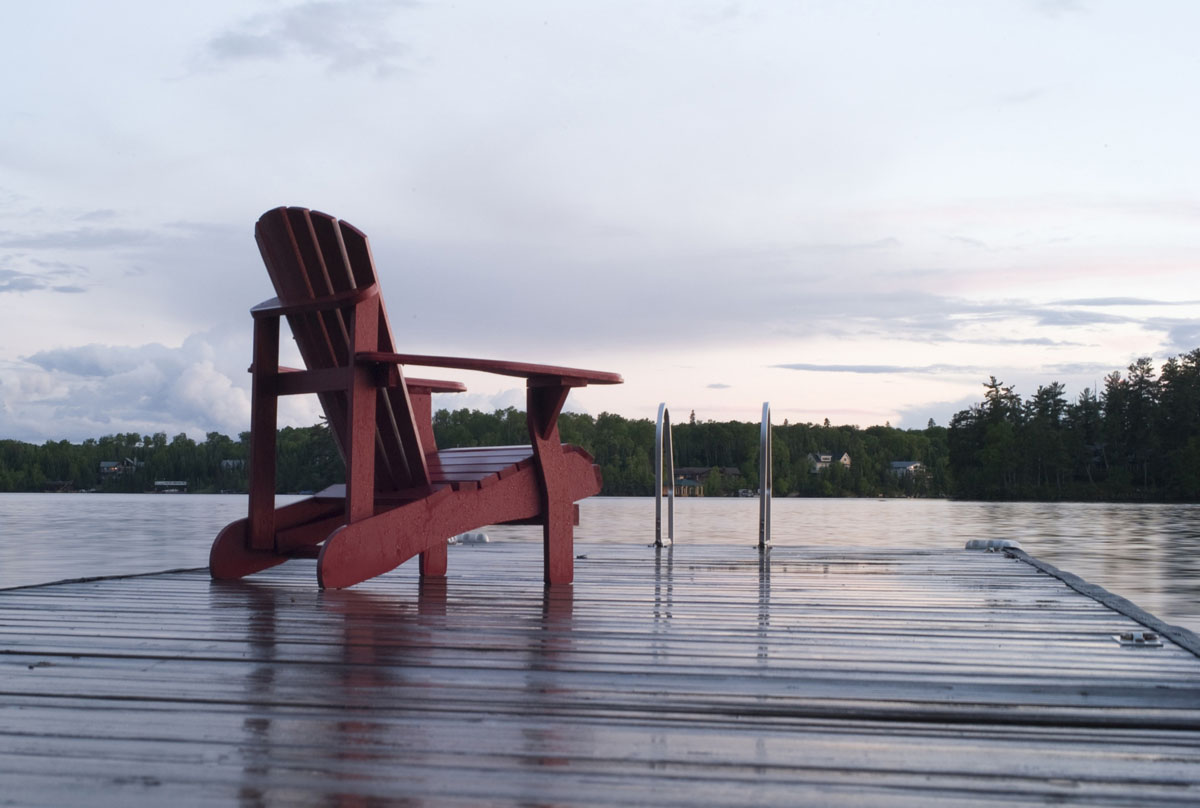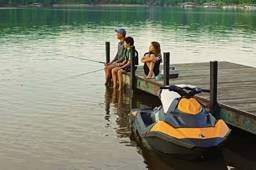If your place is on a lake, pond or river, your springtime maintenance rituals probably include taking stock of your dock and boat lift. The April 2013 issue of Cabin Life addressed lifts, so we’ll now take a look at docks.
Dock edges, railings and pilings are the first line of defense against boaters, sun, wind and waves. Over time, even treated wood will become degraded and begin to rot.
REPLACING WOOD: When swapping out your decking, consider composites. Though they are more expensive, they’ll last longer than treated wood, and can be kinder to the environment. Check local regulations regarding treated wood; many lakes don’t allow construction and repair with creosote or Chromated Copper Arsenate (CCA) treated wood, as these chemicals can leach from the wood into the lake.
Other decking options include aluminum and vinyl. Scott Quick, of D.H. Docks & Tracks, reports that vinyl decking accounts for about 75% of his sales. And FLOE International has a cedar-look aluminum decking with UV-protectant that is increasingly popular with customers.
Dock edges, railings and pilings are the first line of defense against boaters, sun, wind and waves. Over time, even treated wood will become degraded and begin to rot.
REPLACING WOOD: When swapping out your decking, consider composites. Though they are more expensive, they’ll last longer than treated wood, and can be kinder to the environment. Check local regulations regarding treated wood; many lakes don’t allow construction and repair with creosote or Chromated Copper Arsenate (CCA) treated wood, as these chemicals can leach from the wood into the lake.
Other decking options include aluminum and vinyl. Scott Quick, of D.H. Docks & Tracks, reports that vinyl decking accounts for about 75% of his sales. And FLOE International has a cedar-look aluminum decking with UV-protectant that is increasingly popular with customers.
SCREWS OR NAILS: Not a lot of people use nails anymore, unless they are using a harder wood like cedar for their dock. Galvanized or coated decking screws last much longer and are easy to install; most important, they keep dock components tightly fastened together.
EDGING/RUB RAILS: Is it time to replace those old lengths of fire hose and tires you use on deck edges and pilings to protect them and your boat? There are many sources for quality vinyl dock edging, just be sure to look for the marine-grade stuff that won’t deteriorate or crack from exposure to sun, water and temperature swings.
STAIN & PRESERVATIVE: Environmental consciousness is key when applying a stain or preservative to your dock. Water-based products are the rule, and applying them in the off-season when water levels are lower will allow you to cover more of your dock while making it easier to keep the stain away from the water.
EDGING/RUB RAILS: Is it time to replace those old lengths of fire hose and tires you use on deck edges and pilings to protect them and your boat? There are many sources for quality vinyl dock edging, just be sure to look for the marine-grade stuff that won’t deteriorate or crack from exposure to sun, water and temperature swings.
STAIN & PRESERVATIVE: Environmental consciousness is key when applying a stain or preservative to your dock. Water-based products are the rule, and applying them in the off-season when water levels are lower will allow you to cover more of your dock while making it easier to keep the stain away from the water.
ShoreDocker
This nifty dock accessory comes in kit form, where you supply the framing lumber, and ShoreDocker supplies the brackets, frames, and hardware. Three models are available: 1,200-pound and 2,000-pound capacity versions for personal watercraft, runabouts, and fishing hulls, and a 2,000-pound capacity pontoon model. All include winches and rollers, and the frames are made from hot-dipped galvanized steel for corrosion resistance and long life. www.shoredocker.com
This nifty dock accessory comes in kit form, where you supply the framing lumber, and ShoreDocker supplies the brackets, frames, and hardware. Three models are available: 1,200-pound and 2,000-pound capacity versions for personal watercraft, runabouts, and fishing hulls, and a 2,000-pound capacity pontoon model. All include winches and rollers, and the frames are made from hot-dipped galvanized steel for corrosion resistance and long life. www.shoredocker.com
WHEEL IT IN
Boat ramps that can be assembled at the shoreline and used to pull your boat up out of the water when not in use offer utility and convenience. They make it easier and safer to get your boat onto solid ground (no worries about sinking or wave damage), and they keep it cleaner and free from accumulated lake grime.
Boat ramps that can be assembled at the shoreline and used to pull your boat up out of the water when not in use offer utility and convenience. They make it easier and safer to get your boat onto solid ground (no worries about sinking or wave damage), and they keep it cleaner and free from accumulated lake grime.
Roll-n-Go
This company builds lightweight, all-aluminum, portable ramps, available in 750-, 1,200-, and 2,000-pound capacities for PWC and runabouts. Also available: 2,000-pound-capacity pontoon ramps, extensions for very shallow drop-offs, anchor kits, and winches. www.roll-n-go.com
This company builds lightweight, all-aluminum, portable ramps, available in 750-, 1,200-, and 2,000-pound capacities for PWC and runabouts. Also available: 2,000-pound-capacity pontoon ramps, extensions for very shallow drop-offs, anchor kits, and winches. www.roll-n-go.com
 Thinkstock.com
Thinkstock.com 
 Thinkstock.com
Thinkstock.com 








